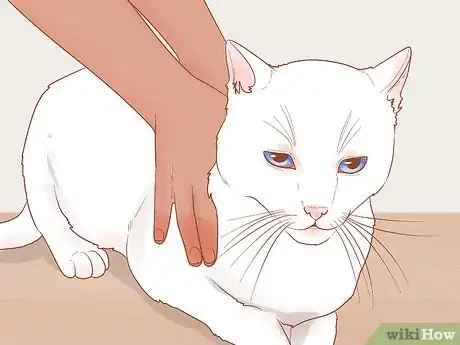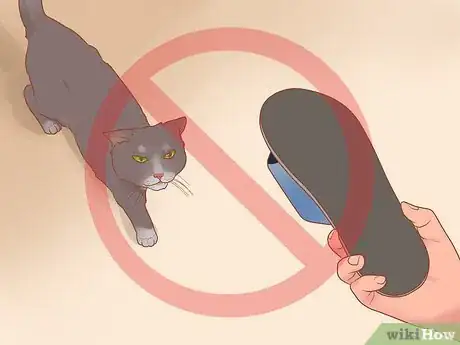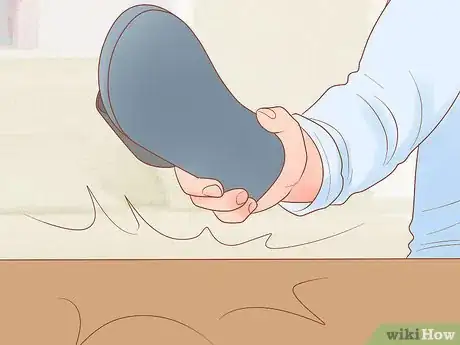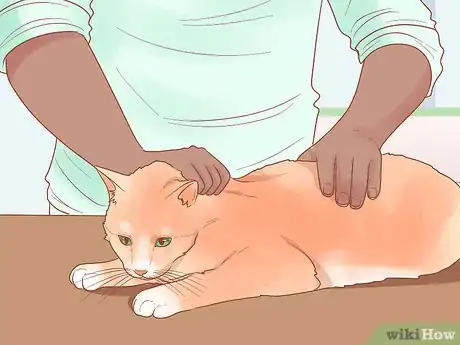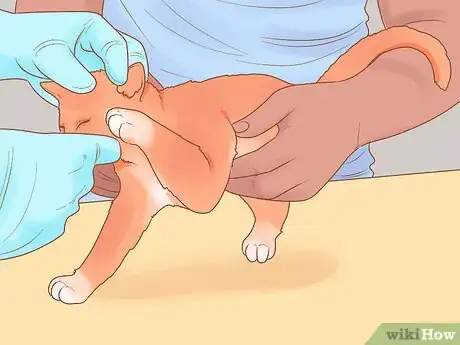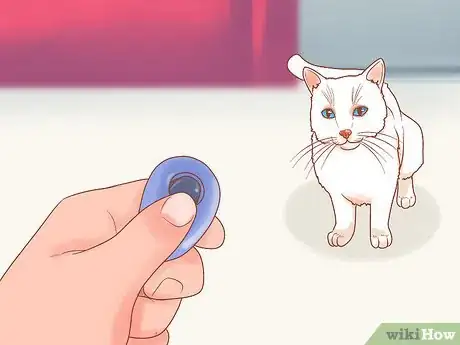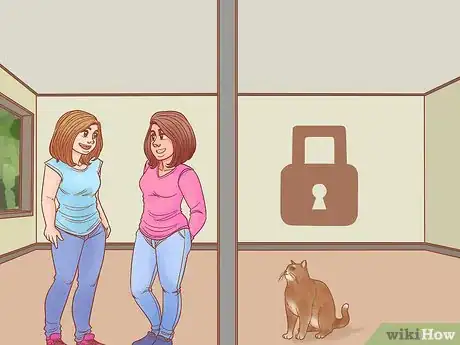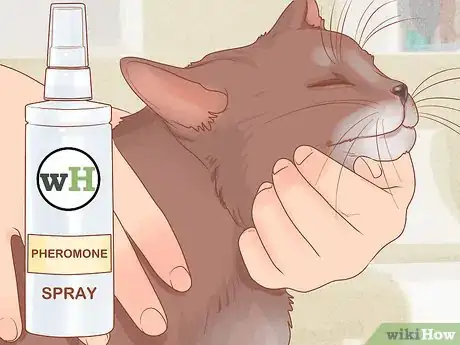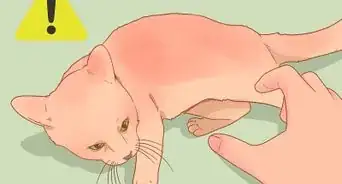This article was co-authored by Deanne Pawlisch, CVT, MA. Deanne Pawlisch is a Certified Veterinary Technician, who does corporate training for veterinary practices and has taught at the NAVTA-approved Veterinary Assistant Program at the Harper College in Illinois and in 2011 was elected to the board of the Veterinary Emergency and Critical Care Foundation. Deanne has been a Board Member of the Veterinary Emergency and Critical Care Foundation in San Antonio, Texas since 2011. She holds a BS in Anthropology from Loyola University and an MA in Anthropology from Northern Illinois University.
This article has been viewed 77,569 times.
Sometimes a cat that is overstimulated will suddenly attack you, whether because it is playing roughly or it is redirecting aggression. If this happens, you should stay calm and try not to surprise the cat so it releases you. It's also important to know how to train or encourage a cat not to act this way in the first place. Minimizing the impact and frequency of a cat's attacks is important for your health and that of the cat.
Steps
Getting the Cat to Stop its Attack
-
1Act calmly. Reacting strongly can increase the cat's stress and interest in attacking you. It may even make the cat's prey instinct kick in more, spurring it on to bite down harder.[1] Instead, stop moving and reacting to the cat. This will take away all the fun the cat gets from the attack.
- If you don't "play" with the cat any further, it will likely lose interest and release its claws or teeth.
-
2Press towards the cat. If the cat has its claws or teeth in you, then you need to work on getting the cat to remove them. Instead of pulling away, try pushing toward the cat further. This will hopefully confuse the cat, prompting it to let go.[2]
- Pressing towards the cat will get the cat to release because prey don't usually move toward the cat after an attack.
- While cat bites are typically small, they're also deep, and the bacteria from the cat's mouth can get into the wound and cause an infection. If you get bitten, wash the wound with soap and water right away and then see a doctor.[3]
Advertisement -
3Do not use physical punishment. Hitting or smacking the cat will only increase the stress and aggression it is feeling. While physical resistance may be your first response when being attacked, resist that urge.
- You can, however, use a strong and stern voice to admonish the attacking cat. This will show the cat your displeasure while not increasing its attacking instinct.
-
4Make a sharp or unexpected noise. Making a loud noise can shock the cat into releasing its grip if it is unwilling to give up on its attack. Try making a loud noise or throw something across your room that will make a loud noise when it hits the floor.
- You can try to shock the cat by simply clapping very loudly.
-
5Restrain the cat. If all else fails, you may need to restrain the cat. This can usually be done most easily during an attack by scruffing the cat. Holding the cat by the scruff will disable the cat and allow you to get control of it.
- Scruffing a cat needs to be done with caution. Holding the cat by the loose skin at the back of the neck in the right way is not painful, but doing it wrong can injure the cat.[4]
- Ask your veterinarian how to scruff a cat and try it on a cat that is docile. This will assure that you know how to do it before you have to do it to a cat that is out of control.
Getting Away From the Cat
-
1Remove yourself from the situation. Once you have gotten the attacking cat off of you, walk away from it. Do not interact with the cat at all and just move away from it. This will help to diffuse the situation.
- An aggressive cat is likely to continue its behavior if it gets a reaction or interaction due to the attack.
- This is especially helpful in dealing with a cat who is having a redirected aggression issue. Redirected aggression occurs when the cat becomes upset because of another animal, a person, or an event, but is unable to direct their aggression towards the stimulus. As a result, the cat will redirect its aggression to the first person, animal, or thing that it can.[5]
- Removing yourself is also useful when dealing with a kitten that is playing too roughly. Withdrawing your attention if the cat plays too roughly will show it that the fun stops when they play too hard.[6]
-
2Allow the cat to leave the area. Do not keep an aggressive cat in a room if it doesn't want to stay. Allow it to leave if it wants to so that it can go off on its own and cool down. For example, cats may act aggressively if they are scared, so letting it flee instead of keeping it in a fearful situation will reduce its stress and allow it to stop being aggressive.
- Sometimes a cat will attack because it did not want to be interacted with. If this is the case for you, then you should allow it to get the alone time that it wanted.
-
3Isolate the cat. If the cat is wild and you are fearful that it will continue to attack you, or injure itself, you may need to isolate it. This can be done most effectively and humanely by locking it in a room by itself until it has completely calmed down.
- If you place an aggressive cat in a room by itself for longer than an hour or so, you should supply a litter box, food, and water for it.
Preventing Your Cat From Attacking
-
1Have your cat's health assessed. Aggression in cats can sometimes be caused by medical problems. If your cat is feeling unwell or suffering, it could make the animal angry or unpleasant. To make sure that a health problem is not the cause of your cat's aggression, you should have it looked at by a veterinarian.
- Some medical problems that can cause aggression in cats include dental disease, arthritis, and hyperthyroidism.
-
2Change factors than may be causing aggression. If your cat's health is fine, then its aggression has another cause. You should assess its living conditions to try and figure out what it causing its anger. The aggression may be caused by factors such as dirty litter, territory disputes with other cats, lack of socialization, or previous trauma. If you think your cat is unhappy about one of these things, change it.
- It is best to figure out the source of your cat's aggression as soon as possible once aggression starts. This will help you to stop the cat's aggression from becoming habit.
-
3Train your cat not to attack. Once you have eliminated any health or situational problems that are causing your cat to attack, you should work on training it not to attack any more. This training should include interrupting aggressive behavior before it escalates.
- You should not use physical punishment or physical contact when training your cat not to attack. This will likely cause the cat to become more fearful and unsettled, thus increasing the likelihood of an attack.
- If your cat is food focused, then treats can be used to reward non-aggressive behavior. For example, if your cat is aggressive toward strangers, you can give visitors treats they can give to the cat if it is calm with them.
-
4Keep your cat out of aggression-inducing situations. If you have figured out what triggers your cat's aggression, then you should try to keep it out of those situations. For example, if your cat is triggered by strangers in your home, then you should keep it sequestered away when strangers come to your home.
-
5Calm your cat with pheromone products. Pheromones are a chemical form of communication within a species. Some pheromones have a calming effect, and there are cat-specific products, such as collars and sprays, that incorporate this pheromone in order to give your cat a calmer demeanor. Try using one or more of these products on your cat to relax them.[7]
-
6Get your cat professional help. If you have tried to ease your cat's aggression and have not had any success, then it's time to call in a professional. Contact your veterinarian and see what they can do about your cat's aggression. You can also contact a board certified veterinary behaviorist to help your cat overcome its aggression.
- Your veterinarian may suggest giving your cat medication in combination with behavioral training. This can ease your cat's stress and minimize aggressive outbursts.
References
- ↑ http://www.catbehaviorassociates.com/stop-your-cat-from-biting-your-ankles/
- ↑ http://www.catbehaviorassociates.com/stop-your-cat-from-biting-your-ankles/
- ↑ https://vcahospitals.com/know-your-pet/wounds-cat-bite-injuries-to-humans
- ↑ http://www.cathealth.com/how-to/how-to-scruff-your-cat
- ↑ https://vcahospitals.com/know-your-pet/cat-behavior-problems-aggression-redirected
- ↑ http://www.humanesociety.org/animals/cats/tips/kitten_play.html
- ↑ http://pets.webmd.com/features/pet-pheromone-products-for-behavior-problems#1
About This Article
If a cat suddenly attacks you, try to stay as calm as possible and avoid hitting it, since reacting strongly can actually increase the cat's stress and interest in you. If the cat has its claws or teeth in you, try pushing toward the cat rather than pulling away to get it to release. Making a sharp, unexpected noise can also startle a cat into releasing its grip. Once you've stopped the attack, walk away from the cat and avoid interacting further to diffuse the situation. For tips from our Veterinary co-author on preventing aggression in cats, read on!

